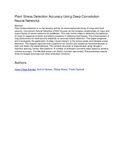| dc.contributor.author | Kirongo, Amos Chege | |
| dc.contributor.author | Omieno, Kelvin | |
| dc.contributor.author | Mutua, Makau | |
| dc.contributor.author | Ogemah, Vitalis | |
| dc.date.accessioned | 2021-06-08T12:15:02Z | |
| dc.date.available | 2021-06-08T12:15:02Z | |
| dc.date.issued | 2019-08 | |
| dc.identifier.uri | https://doi.org/10.32628/CSEIT195447 | |
| dc.identifier.uri | https://www.researchgate.net/publication/335461421_Plant_Stress_Detection_Accuracy_Using_Deep_Convolution_Neural_Networks | |
| dc.identifier.uri | http://r-library.mmust.ac.ke/123456789/1640 | |
| dc.description.abstract | Plant Stress detection is a vital farming activity for enhanced productivity of crops and food security. Convolution Neural Networks (CNN) focuses on the complex relationships on input and output layers of neural networks for prediction. This task further helps in detecting the behavior of crops in response to biotic and abiotic stressors in reducing food losses. The enhancement of crop productivity for food security depends on accurate stress detection. This paper proposes and investigates the application of deep neural network to the tomato pests and disease stress detection. The images captured over a period of six months are treated as historical dataset to train and detect the plant stresses. The network structure is implemented using Google’s machine learning Tensor-flow platform. A number of activation functions were tested to achieve a better accuracy. The Rectifier linear unit (ReLU) function was tested. The preliminary results show increased accuracy over other activation functions. | en_US |
| dc.language.iso | en | en_US |
| dc.publisher | International Journal of Scientific Research in Computer | en_US |
| dc.subject | Plant, Stress, Detection, Accuracy, Deep, Convolution, Neural, Networks | en_US |
| dc.title | Plant Stress Detection Accuracy Using Deep Convolution Neural Networks | en_US |
| dc.type | Article | en_US |

